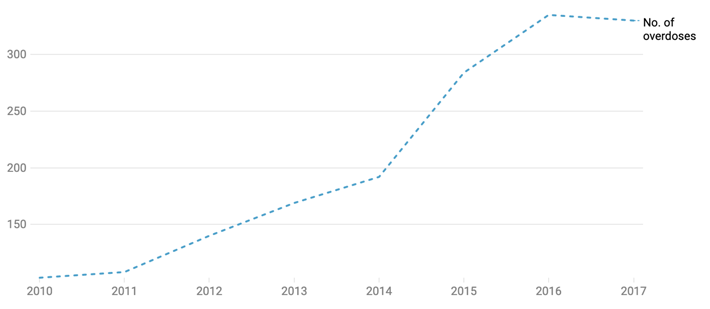Methamphetamine Deaths Surge in Oklahoma

Many have heard its name, but not all know what this drug is: Methamphetamine is a powerful, highly addictive stimulant drug. The drug affects the central nervous system, causing a spike in heart rate, increased energy and often delusional behavior. The drug can look like glass fragments or shiny, bluish-white rocks in its purest forms, or it can look like peanut butter when made with impurities. Methamphetamine is sold legally as Desoxyn and is prescribed for weight loss and other disorders it is chemically similar to the pharmaceutical drug amphetamine. No matter what form it comes in, the substance is easily abused and often deadly.
People take meth illicitly by smoking it, swallowing it, snorting it, or injecting the crushed powder after it’s been dissolved in water. Methamphetamine causes its mind-altering effects by increasing the amount of the natural chemical dopamine in the brain, altering body movement, motivation, and reward sensations. Once meth causes a dopamine release, this then results in a “feel good” phenomenon, a surge of energy, or a rush of euphoria.
Methamphetamine Addiction: A Public Health Emergency in Oklahoma

One does not have to look far to find public health reports outlining the crisis of meth addiction in Oklahoma. For Oklahomans, it is an open secret that the state struggles with meth addiction, a local health epidemic that saw meth-related overdose fatalities surge by over 220% between 2010 and 2017. Further, while opioid addiction has claimed much of the public health spotlight in the state due to the national attention on opioids, meth is actually found in more drug-related fatalities in Oklahoma than opioids.
While the number of meth lab seizures in Oklahoma has fallen over the years due to law enforcement crackdowns and new laws inhibiting the sale of pseudoephedrine (a key ingredient in making meth), meth addiction and deaths have gotten worse. This point is emphasized by Mark Woodward, spokesman for the Oklahoma Bureau of Narcotics & Dangerous Drugs Control. In his own words, “It’s just not making the headlines, and it should be. I think too many people are under the impression that when meth labs went away, meth deaths went away.” To address the problem that Mr. Woodward laid out, Oklahoma public health officials recently launched campaigns to inform the public about the danger of meth in the hopes that residents will become more informed and seek help when needed.
“It’s just not making the headlines, and it should be. I think too many people are under the impression that when meth labs went away, meth deaths went away.”
Many local experts believe the surge in deaths resulted from highly potent meth trafficked into the state by Mexican drug cartels. According to state officials, meth is more accessible in Oklahoma now than it was when the state had more meth labs. And it’s cheaper too. Today, meth in Oklahoma goes for $250–$800 an ounce, not the $1,000–$1,400 that dealers were charging in 2014. To that point, Dr. Jason Beaman, a leading specialist at the Oklahoma State University Center, shed light on the critical issue. “It’s (the meth is) much different. … It’s extremely high quality—100 percent pure meth. It’s consistent product, not a lot of variability. It’s just so pure, and we’re just seeing a lot of deaths,” he said. From that, it’s safe to conclude the increased purity coupled with a cheaper product and lack of addiction treatment options undoubtedly contributed to the spike in deaths.
Finally, much of Oklahoma’s addicted population is getting older, and their bodies cannot handle the new, extremely potent strains of meth. Here too there are local public health officials, like Mr. Woodward, who’ve provided insight into the problem. “I think one of the things also contributing is these meth addicts have been using since the 90s. Their bodies are wearing out. They’re using the same amount, but their bodies are not what they used to be,” he said. An aging population of meth users more at-risk for overdose deaths is yet another indication that Oklahoma addicts must seek treatment before it is too late.
Lab Seizures Down, Meth Seizures Up
Even though meth lab seizures are down in Oklahoma, seizures of illegally trafficked meth are still ongoing, indicating that the quantity of meth available in Oklahoma has not dropped. One report broke the news that over 10,000 pounds of meth were seized in Oklahoma during the Covid-19 pandemic.

Source: Oklahoma Bureau of Narcotics Drugs & Dangerous Drugs Control
The fact that an impressive crackdown on locally produced meth has not resulted in a drop in meth addiction in the state (Oklahoma addicts now get their meth from numerous Mexican cartels) is a good example of how the drug problem is not a supply issue, but a demand issue. As long as there is a demand for drugs, drugs will exist. This is why it is so important to get addicts off drugs once and for all through addiction treatment, and not to focus solely on reducing the supply of drugs.

Source: Oklahoma Bureau of Narcotics Drugs & Dangerous Drugs Control
Meth Addiction a Lethal Problem Nationwide
While Oklahoma’s problem is severe, it is not the only state suffering a spike in meth addiction and overdose deaths. According to the National Institute on Drug Abuse, overdose deaths involving meth almost tripled between 2015 and 2019 among people ages 18 to 64.
Further, while the number of individuals in the U.S. using meth did increase, it did not increase by 300% (which would have been proportional to the increase in overdose deaths). That suggests the meth of today is a far more dangerous version of the drug than the meth of previous years. In fact, there is even published research that lays out the case for this from the National Institute on Drug Abuse. Taking a look at one of their studies, they wrote, “From 2015 to 2019, the number of overdose deaths involving psychostimulant drugs other than cocaine, (largely methamphetamine), rose from 5,526 to 15,489, a 180% increase. However, the number of people who reported using methamphetamine only increased by 43% over the same period.” Clearly, the meth of today is more potent and dangerous than it used to be.
Another factor observed in Oklahoma and nationwide is the growing trend of drug dealers mixing the synthetic opioid fentanyl into batches of meth to make it more potent and addictive. Sadly, this also makes the drug far more deadly. NIDA has reported extensively on this, with NIDA Director Dr. Nora Volkow writing about it. In her words, “We are in the midst of an overdose crisis in the United States, and this tragic trajectory goes far beyond an opioid epidemic. In addition to heroin, methamphetamine and cocaine are becoming more dangerous due to contamination with highly potent fentanyl, and increases in higher-risk use patterns such as multiple substance use and regular use.” The addition of fentanyl into the meth supply poses an extreme risk to users, most of whom are not expecting to consume adulterated meth.
Addiction Treatment is the Answer to Meth Addiction
People hooked on meth almost always require professional help to get off the drug, as it is extremely addictive. Residential addiction treatment centers are the answer for people addicted to meth because such programs possess the tools, environment, staff, support, and resources that addicts need to overcome addiction.
If someone you know is struggling with an addiction to meth, please get them help at a qualified drug rehab center as soon as possible. Please don’t wait until it is too late for them. Contact a drug rehab center today.
Sources:
- https://nida.nih.gov/publications/drugfacts/methamphetamine
- https://www.readfrontier.org/stories/its-our-no-1-killer-deaths-linked-to-meth-have-surged-in-oklahoma/#
- https://okcfox.com/news/local/over-10000-pounds-1300-liters-of-meth-seized-in-oklahoma-n-tx-during-pandemic
- https://nida.nih.gov/news-events/news-releases/2021/09/methamphetamine-involved-overdose-deaths-nearly-tripled-between-2015-to-2019-nih-study-finds


